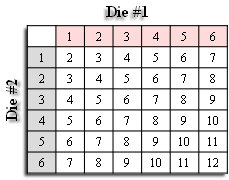Dice are familiar tools in most mathematics classrooms. Their use in primary school games allows students to build preliminary notions of number and autonomy. (see Kamii) As the grades progress, dice sums become too simple and the tool is pushed into the realm of probability and chance. There, alongside decks of cards and coloured spinners, it enjoys almost godly status; it seems that there is no better way to calculate odds than to role dice and spin spinners (in outrageous cases—simultaneously).
The greatest thing dice have going for them is familiarity. Teachers can use this to upset the thinking of students and encourage them to think mathematically to resolve their cognitive conflict. A great example of this is my Fair Dice Task. Here students encounter dice that act in—seemingly—strange ways. They grapple with the structure of the problem to restore a sense of homeostasis.
Here I want to explore how students use their number sense and logical thinking to piece together unfamiliar dice. I begin by introducing a chart that shows the sums of the faces when rolling two dice.
We discuss the possible patterns that emerge and any symmetry that exists. I then hand out a sheet of blank dice charts and reformulate the task.
What if I gave you the 36 possible sums? Could you then tell me what the dice look like?
I haven’t decided the best way to list out the 36 numbers. You could project them on the board, but then students may make counting errors that would derail the underlying focus of the task. I think each group should have a set of data, and mistakes should be erasable. I have settled on giving each group a plastic sheet cover and handing them a dry erase marker and a sheet of data. Each data sheet has a place for them to write their guiding rules. My goal is to compile these “rules” and have them fuel a class discussion. Each sheet also has a “final answer” grid.
I try and start with simple dice and move into more complex. The whole time I encourage them to write down any “advice” they have in the form of rules.
I visit each group and take note of any differing strategies. I pay special attention to those I would like to highlight. I am sure to discuss this example with the class to keep the task floor low. That is to say, I want every student to have a shot at achieving some sort of mathematical accomplishment.
I want to see if students can sense if the dice doubles. Maybe there is a rule that can be developed.
Here I am looking for logical partitioning of numbers. I want the students to see the number “eight” flexibly. Within this context, eight will have two parts. Each constituent represents a side of a dice. Can students use the structure of numbers to break down tasks?
Depending on the flow of the lesson, I like to throw out some other questions. These would also serve as great extensions.
What if every sum was even? What could you tell me about the sides of the dice?
What if every sum was odd? What could you tell me about the sides of the dice?
Can you design two dice (with numbers 1-6) that never sum to 8? to 1?
What if half of the sums were sixes? What could you tell me about the sides of the dice?
The task requires a large amount of logical thinking and numerical flexibility.
If you wanted to move into the topic of factors (or even greatest common factor), you could present the same structure but give them the product of the dice faces. Prime numbered faces would present an interesting twist under these parameters.
On the whole, the task takes a familiar object creates a cognitive conflict by skewing its attributes. I’m having trouble penciling it explicitly into a “unit” under a “topic”, but any suggestions are more than welcome.
NatBanting

2 replies on “Dice Sums Task”
I have run a number of math circles, and this sounds like a perfect exploration for a math circle. I might try it in July. If I do, I'll let you know how it went.
I love what you've done here. Thank you for sharing it.
Any feedback would be greatly appreciated. I sort of had the same venue in mind for something like this.
Thanks for reading.